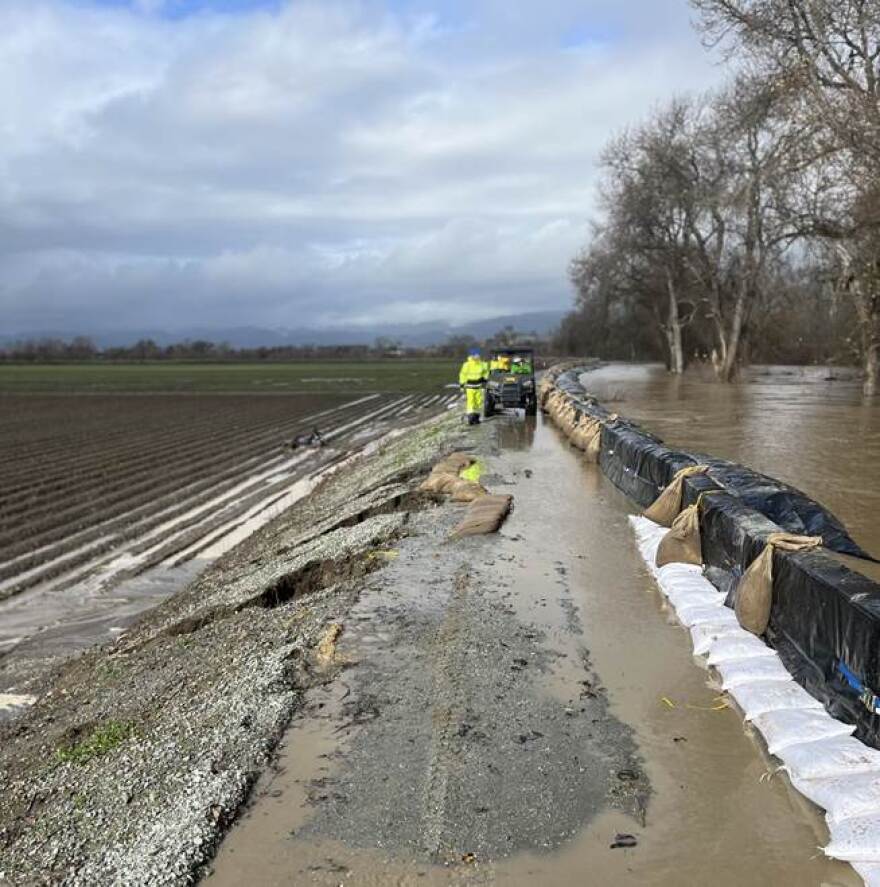Communities along the Pajaro river narrowly avoided disaster in January, as aging levees struggled to hold back catastrophic flood waters during relentless storms. Despite decades of neglect and a growing awareness of the levees’ dire condition, a permanent fix is still years away.
Local authorities say they worked tirelessly during the storms to prop up the levees and protect the thousands of residents who live on either side of the Pajaro river, which acts as a boundary between Santa Cruz and Monterey Counties. They say those emergency efforts may not be enough in future storms.

“We have to triage all those situations and put Band-Aids on a system that needs to be rebuilt,” said Mark Strudley, Executive Director of the Pajaro Regional Flood Management Agency, which maintains the system.
Workers patrolled the 13 miles of levee on foot day and night, and flew drones to search for weak spots. In multiple cases, crews had to make repairs even as wind and rain buffeted the area, destabilizing the levees and the land around them.
“Heavy equipment moving around out here was literally making the landscape shake like you're standing on a trampoline,” Strudley said. “It’s incredibly unnerving.”
Along the Santa Cruz County side, near the city of Watsonville, emergency crews installed what is known as a “seepage berm”— tons of rock piled up for about 2,000 feet along the outside of the levee to keep it from eroding.
In the community of Pajaro on the Monterey County side, where the levee is slightly lower, they placed a temporary flood barrier known as a “muscle wall” on top of the levee to keep it from overflowing.

The muscle wall proved to be essential. At the peak of the storms, the water rose several inches up the side of the wall. If the barrier had not been there—or had not stayed in place—the river water would have poured over the levee and into the town below. Officials became alarmed when water began seeping underneath the muscle wall, but in the end the barrier held.
“We came amazingly close to a repeat of the 1995 flood, which completely engulfed the town of Pajaro and sadly killed two people,” Strudley said.

Authorities nonetheless evacuated the town for seven days as a precaution, forcing many of its 3,300 residents out of their homes and out of work. While some refused to leave, Yvonne Castañeda felt she had no choice.
“I wasn't trying to risk anything. I have two small children,” she said.
Businesses were forced to shut down, too.
At H&R Tools on Porter Drive, owner Beto Romero said he lost precious revenue not only during the evacuation, but for days after as the town struggled back to life.
“I don’t like it because I lose business,” he said. “Probably a week and a half.”
Strudley says the authorities take the hardship caused by the evacuations seriously.
“But when those evacuation warnings or orders are made, they’re made in all seriousness, because there is an actual threat,” he said.
As stressful as the situation along the Pajaro River got last month, it is nothing new, according to lifelong resident Chuck Allen, a Watsonville-based real estate broker specializing in agricultural properties.

“I remember when the original levees were built,” he said.
The U.S. Army Corps of Engineers completed the levee system in 1949. Just six years later, the system failed in the flood of 1955. Ever since, locals have pushed to get the levees rebuilt. Congress did agree to authorize a fix, but that was in 1966, and nothing ever came of it.
“I can’t tell you how many meetings I’ve attended with our community members and one colonel or general after another,” Allen said. “By the time we get some momentum going, they would retire.”
A bigger issue, Strudley said, is that a federal formula prioritized flood protection projects based on the property value of the land around them.
That placed Watsonville, Pajaro, and the surrounding farmland at a disadvantage. Those policies gradually changed under the Trump and Biden administrations, he said.

Finally, last year, Congress approved $149 million in funding under theBipartisan Infrastructure Law to rebuild the levee system, bringing it up to 100-year flood protection. The federal government is expected to ultimately cover 65% of the $400 million project, with the state covering the rest.
Local governments will cover maintenance of the new system. Central to that is the Pajaro Regional Flood Management Agency, a joint effort by Santa Cruz and Monterey Counties formed in 2021 to spearhead the project.
Strudley believes the efforts to rebuild the levees might finally have turned the corner.
“This is a priority project for the federal government. It is a priority with the state as well. There’s a tremendous amount of support from the state,” he said. “So, I’m very confident it’s going to get built”
The project is still in the design phase, with construction not scheduled to begin until 2025. It is expected to take another 10 years to complete.
“It’s a very large project. It’s going to take a lot of construction seasons to get it built,” Strudley said.
That includes a lot of storm seasons and, most likely, a lot of anxious moments along the Pajaro River for some time to come.



